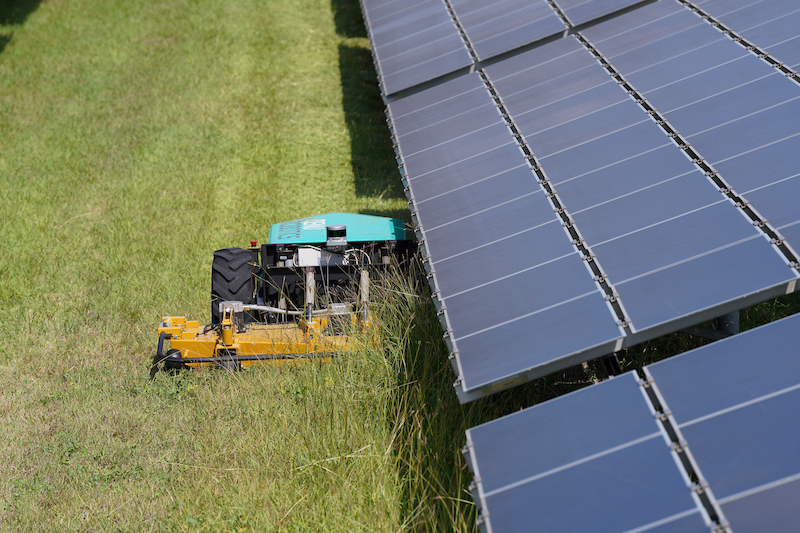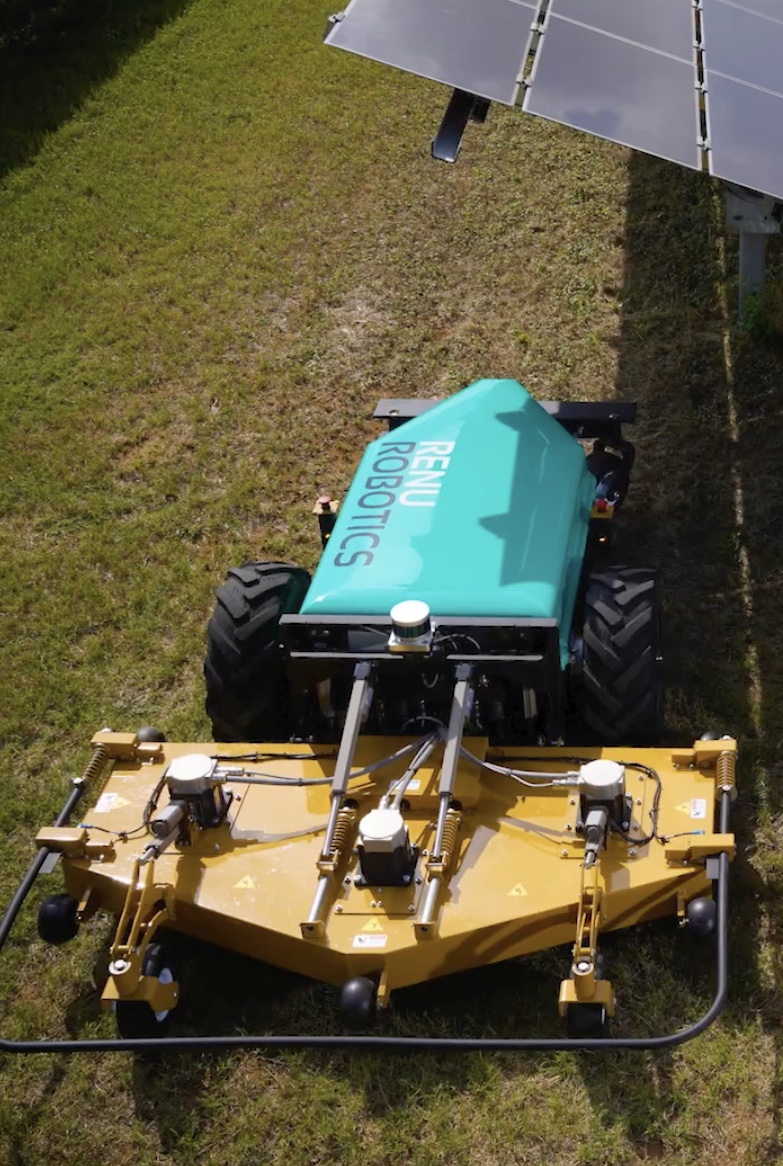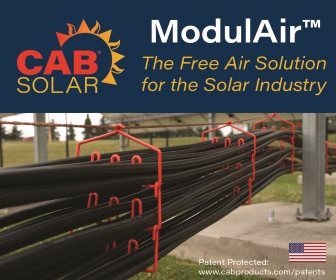Mowing Makes Dollars & Sense
In the days before utility-scale solar facilities stretched to the horizon, vegetation management wasn’t a worry; a small crew could handle it. One longtime industry pro recently told me this was still true as recently as 10 years ago. For the many O&M directors whose number one budget concern is vegetation management, however, that may seem like a hundred years ago.
Generally speaking, as utility-scale output escalated, the practice of mowing the grass evolved into doing it as infrequently as possible because of rising cost. At some point, herbicides were used more frequently, which ended up causing various problems — not the least of which were the environmental concerns and massive soil erosion during downpours.

Today, vegetation management can be divided into three methods: landscape crews, livestock (specifically sheep and goats), and the increasing trend of all-electric autonomous mowers. Rather than explore each method, let’s underscore the reasons why keeping the grass maintained (mowed) at solar facilities not only is an important practice for site performance, but also makes dollars and sense, especially for asset managers.
Looking ahead, solar industry growth is projected to quadruple in the next five years. To say that vegetation management is a growing problem would be an understatement.
The overarching point is that there are many benefits to keeping the grass mowed to a certain height on a routine basis. The wild card to all of it is weather in general, and climate change in particular.
A recently released report shows the last eight years have been the eight warmest on record. An analysis by the European Union’s Copernicus Climate Change Service, published in early January, said 2022 was the fifth-warmest year for the planet since records began. As the debate rages on, one aspect that’s clearly critical for the future is the elimination of C02.
It goes without saying that when saplings are growing up between the panels, or the grass in the rows is so high it’s covering the bottom portion of the panels, it isn’t good. So here are the main reasons why vegetation management is essential to supporting site performance:
- Albedo
- Root structure/Soil retention
- Dust reduction
- Minimizing wildfire risk
- Wildlife management
Albedo
Considering the science involved in ground reflection and the myriad of other aspects on this topic, this will be a quick overview. After scanning several years’ worth of studies posted online around utility-scale solar photovoltaic (PV) plants using bifacial panels, there’s a mountain of research on snow, gravel, cement, sand, and grass in the ground vegetation category. Yet, there is very little, specifically, on the properties of short grass. One study did report that the albedo value of vegetation depends on its characteristics, such as a water layer on grass blades acting as a lens that reflects sun rays in different directions; it sounds like there could be a future study on both direct and reflected solar radiation from various levels of maintained grass (and a series of articles to follow). European studies have found that using vegetation instead of gravel resulted in a five-degree cooling effect. The research also underscored how project managers are increasingly taking vegetation management into consideration when planning and developing large-scale solar facilities.
Root structure/Soil retention
The more that grass grows and remains healthy, the better the root system and soil retention - also known as erosion prevention. Grass is one of the best choices for erosion control because its fibrous roots spread deep and quickly, holding the soil. Water and wind are two of the biggest culprits of erosion, especially during a strong storm when topsoil can erode and be carried away by high winds, resulting in a layer of thick dust. As an overview, we’re not getting into native flora, native plant seeds, various types of crops, or pollinator seeding as part of a facility’s vegetation plan. That’s another article for another day.
Dust reduction
See above, because a landscape of dirt, gravel or sand leads to dust accumulation across hundreds of acres of solar panels. Naturally, when the dust coats the panels with a layer of dirt, it blocks the sun from being absorbed — dirty panels don’t produce as much energy as clean panels, and can lead to lost revenue. In some regions, it’s estimated that dust can reduce the output of PV panels by as much as 30 percent in a month. Primary short-term solutions like water or chlorides can lead to added costs due to labor, equipment and repeated applications. Kripa Varanasi, a professor of mechanical engineering at MIT, estimates that 45 billion liters of water is being used every year to clean solar panels in a process that is costly and unsustainable.
 Minimizing wildfire risk
Minimizing wildfire risk
As temperatures keep breaking records at an escalating pace, the threat of wildfires also is increasing. Wildfire exposure is a significant risk to grid scale, ground-mounted solar photovoltaic assets. The main mitigation against this risk is active vegetation management of the solar PV site, because it removes the source of the fuel that the wildfire requires to spread. As PV sites are unmanned most of the time, site conditions, including change in the vegetation, are only noticed during maintenance activities or during a scheduled site vegetation survey. There have been a number of incidents during the past few years where wildfires have caused significant damage and losses to solar PV sites, mainly in the Western U.S., where the size, severity and frequency are growing at an alarming rate. These losses have been caused by unmaintained or poorly managed vegetation, which could have been avoided had the right prevention strategies been in place. Another aspect of wildfire management is increasing insurance premiums. In fact, some insurance companies require certain vegetation heights. We’re not getting into satellite imagery, drones or AI/autonomous vehicles as surveillance options. Again, another article.
Wildlife management
Keeping the grass mowed at a certain height also prevents, or at least greatly discourages, birds from nesting and a variety of animals and reptiles from making a home on your solar facility. Issues with birds include droppings on panels, and feathers and nesting materials that can not only cause fire, but reduce the effectiveness of panels. The greater the bird and/or animal population, the higher the chance of attracting larger predators. There also is the possibility of maintaining the grass while instituting an agrivoltaics (AV) program and encouraging pollinator habitats.
As an owner or manager of solar assets, you may be able to come up with even more reasons why keeping the grass mowed at solar facilities enhances site performance. The main takeaway is recognizing that the need for vegetation management will only continue to grow as utility-scale solar facilities stretch beyond the horizon in the future.
 Steve Arters is VP – Marketing for Renu Robotics, which provides all-electric autonomous vehicles designed specifically for vegetation management on solar and other energy facilities.
Steve Arters is VP – Marketing for Renu Robotics, which provides all-electric autonomous vehicles designed specifically for vegetation management on solar and other energy facilities.
Renu Robotics | renurobotics.com
Author: Steve Arters
Volume: 2023 March/April











.png?r=6842)
